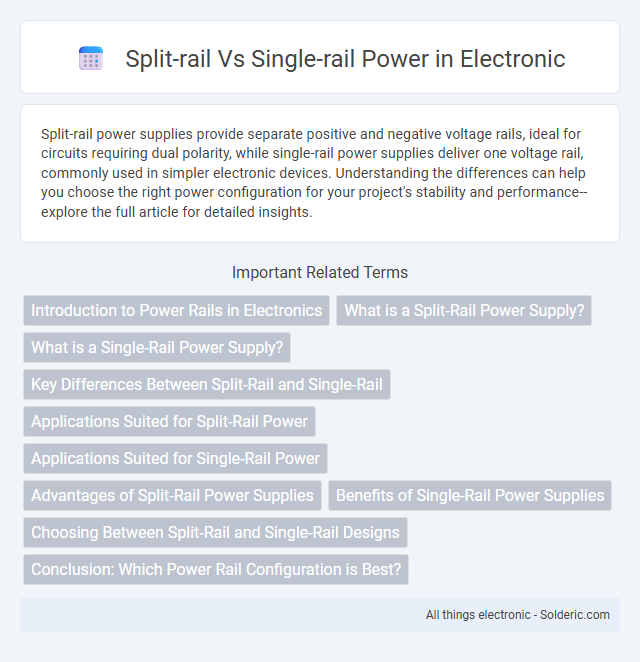Split-rail power supplies provide separate positive and negative voltage rails, ideal for circuits requiring dual polarity, while single-rail power supplies deliver one voltage rail, commonly used in simpler electronic devices. Understanding the differences can help you choose the right power configuration for your project's stability and performance--explore the full article for detailed insights.
Comparison Table
| Feature | Split-Rail Power Supply | Single-Rail Power Supply |
|---|---|---|
| Power Distribution | Multiple +12V rails with separate current limits | One single +12V rail with higher current capacity |
| Current Limit | Limited per rail (typically 20-30A) | Higher overall current limit (up to total PSU capacity) |
| Safety | Better overload protection per rail, reduces risk of short damage | Less granularity in overload protection, potential risk with high current draw |
| Usage | Ideal for multiple high-power components needing isolated supply | Better for high-demand single or combined power loads |
| Complexity | More complex design and wiring | Simpler design and wiring |
| Cost | Generally more expensive | Typically more affordable |
Introduction to Power Rails in Electronics
Power rails in electronics refer to the distribution lines that deliver electrical power to components within a circuit, with single-rail power systems providing a single voltage source to all parts, while split-rail power systems offer multiple voltage levels, typically positive and negative supplies, to support diverse device requirements. Split-rail power is essential for analog and operational amplifier circuits, where dual voltages enhance performance and signal integrity, whereas single-rail power is common in digital circuits with simpler voltage needs. Understanding the distinction between split-rail and single-rail power helps optimize your circuit design for efficiency and functionality.
What is a Split-Rail Power Supply?
A Split-Rail Power Supply provides both positive and negative voltages relative to a common ground, enabling balanced power delivery for circuits requiring dual voltage rails. This configuration is essential for analog devices, operational amplifiers, and audio equipment to function with symmetrical voltage swings. Your choice between split-rail and single-rail power depends on the specific voltage requirements and design complexity of your electronic system.
What is a Single-Rail Power Supply?
A single-rail power supply delivers all of its available current through one unified output voltage rail, typically +12V, ensuring consistent power distribution to components. This design simplifies power management and allows your system to draw as much current as needed from a single source without worrying about load balancing across multiple rails. Single-rail power supplies are favored for gaming PCs and high-performance rigs where stable, uninterrupted power flow is critical for optimal hardware performance.
Key Differences Between Split-Rail and Single-Rail
Split-rail power supplies provide both positive and negative voltage outputs relative to a common ground, allowing bipolar operation essential for audio amplifiers and analog circuits. Single-rail power supplies offer only a positive voltage output with respect to ground, making them simpler and more commonly used in digital electronics and standard power applications. The key difference lies in the voltage configuration, where split-rail supports symmetrical voltage swings while single-rail supplies operate with a single polarity voltage.
Applications Suited for Split-Rail Power
Split-rail power supplies are ideal for applications requiring both positive and negative voltage rails, such as operational amplifiers, audio equipment, and analog signal processing circuits. They enable symmetrical power distribution, ensuring stable performance in instrumentation amplifiers and bipolar analog circuits. These split-rail systems also support balanced signal processing, reducing noise and enhancing precision in sensitive measurement devices.
Applications Suited for Single-Rail Power
Single-rail power systems provide consistent voltage output and are ideal for high-performance applications such as gaming PCs and overclocked processors, where stable power delivery is crucial. They simplify cable management and reduce electrical noise, benefiting compact builds and systems with limited space. These systems are preferred in setups requiring straightforward power monitoring and uniform current distribution to sensitive components.
Advantages of Split-Rail Power Supplies
Split-rail power supplies provide dedicated voltage rails for different components, reducing noise and improving overall system stability compared to single-rail power supplies. They enhance safety by limiting the current available to each rail, minimizing the risk of damage during short circuits or component failures. Your electronics benefit from better voltage regulation and reduced interference, ensuring consistent performance in sensitive applications.
Benefits of Single-Rail Power Supplies
Single-rail power supplies provide a consistent and stable voltage output, reducing the risk of overloading individual rails and simplifying power distribution in devices. They enhance efficiency by delivering maximum power through a single channel, which benefits high-performance systems and gaming rigs. Your components receive steady and reliable power, improving overall system stability and reducing the likelihood of voltage drops during peak loads.
Choosing Between Split-Rail and Single-Rail Designs
Choosing between split-rail and single-rail power designs depends on your device's power needs and performance goals. Split-rail power supplies deliver multiple voltage outputs independently, improving stability and reducing interference for high-demand, multi-component systems. Single-rail designs offer simplicity and consistent power delivery, ideal for setups requiring steady voltage without complex load balancing.
Conclusion: Which Power Rail Configuration is Best?
Single-rail power supplies provide consistent voltage across all components, ideal for high-performance systems with heavy power demands, while split-rail configurations enhance safety by isolating current paths and reducing the risk of overload. Gamers and overclockers often prefer single-rail setups for their simplicity and maximum power delivery, whereas split-rail systems are favored in environments prioritizing stability and protection. Choosing the best power rail depends on the application's power requirements, safety considerations, and user expertise.
Split-rail vs Single-rail Power Infographic

 solderic.com
solderic.com